“The Aramaic leaves have been dated to the fifth century through paleographic grounds, and a few leaves were subjected to radiocarbon dating which supported the date. The Greek leaves are from around the sixth century, and once again the date is based on paleography and radiocarbon dating. The manuscript remained in a library of St. Catherine’s (Monastery) until the 19th century, when leaves were sold to European collectors.”
Private collectors Agnes Smith Lewis and Margaret Dunlop Gibson, who acquired 138 leaves between 1895 and 1906, donated 137 leaves of the manuscript to Westminster College at Cambridge University, and donated the remaining leaf to the University of Birmingham in the United Kingdom, Hyland said.
In 2010, the Green Collection of Oklahoma purchased the 137 leaves from Cambridge and donated them to the Museum of the Bible in 2014.
“In 1975, an additional eight folios of the manuscript were found at St. Catherine’s,” Hyland said, “which helps to establish the monastery as the place where the composite was likely created, and where it stayed until the 19th century.”
Hyland elaborated on the work’s historical significance.
“For the first time, a Greek text of Hipparchus’ lost star catalog has been discovered. There were references to the text, but it has not survived,” Hyland said. “The deciphered portion of text discovered on these leaves contains star coordinates for the constellation Corona Borealis, the Northern Crown. The coordinates closely match what the reconstructed position of the constellation was in 129 BC, when Hipparchus was active. The coordinates are more precise than those given by Ptolemy centuries later.
“This is a remarkable insight into the work of an ancient Greek astronomer. Hipparchus likely had access to Babylonian writings on the position of stars and planets. He also likely made his own precise measurements.”
The Ladder of Divine Ascent is on display at the Museum of the Bible and images are viewable online here.
This article originally appeared here.

